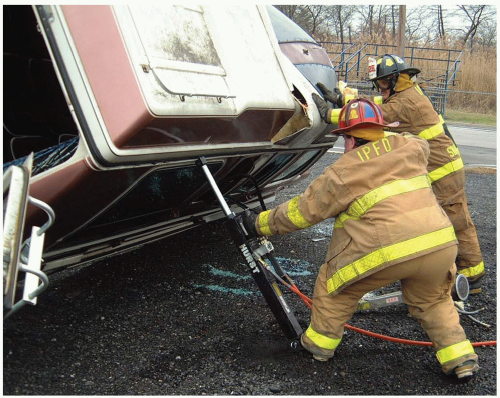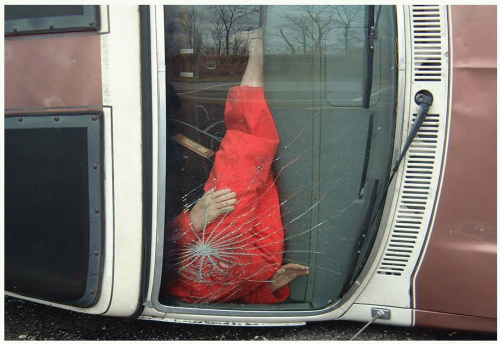Emergency Medical Services and Pre-Hospital Care
2-1 Vehicular Rollover
Gerald Wydro
Of the five types of vehicle collisions—head-on, T-bone, rear-ended, rotational impact, and rollover—rollover has the greatest mechanistic potential for passenger injuries, which are directly proportional to the amount of force required to overturn the vehicle.
Clinical Presentation
The most common rollover is the “side rollover,” which is common in accidents involving sport utility vehicles. It is usually caused by a T-bone collision or when a vehicle strikes a curb, has a blowout, or comes in contact with uneven topography. The second type of rollover involves an end-over-end mechanism by which the vehicle flips bumper-over-bumper. Passenger ejection is common in all rollovers.1
Pathophysiology
Three distinct collisions occur during a motor vehicle collision. The first collision occurs when the vehicle strikes an object. The second collision occurs when the body of the patient strikes the interior of the vehicle or is thrown from the vehicle. The third collision occurs when the organs of the patient strike surfaces within the body.1 Kinetic energy is directly responsible for all second and third collision injuries. The amount of kinetic energy is proportional to the severity of injuries that occur during the accident. Most second collision injuries are easily identified through a good physical examination. They can manifest as soft tissue damage, from simple contusions to major lacerations and avulsions or as musculoskeletal injuries, from closed or open fractures to gross dislocations. Third collision injuries typically are not visible on external examination. Examples include lacerated liver or spleen, other gastrointestinal injuries, brain injuries, and closed chest trauma.
Clinical Complications
Vehicles that have come to rest on their roof or side present obstacles to responders. These vehicles tend to shift, especially with live loads (e.g., patients moving around inside the vehicle). Any vehicle that is on its side or roof is considered to be extremely unstable and should not be entered until it is stabilized. Procedures such as manual cervical spine immobilization and airway control may be complicated by patient positioning.
Management
Scene safety for all responders and patients is the first priority. All vehicles that are unstable must be stabilized before access is gained. All potential passengers must be accounted for. A basic rule of thumb is that the number of passengers to be ruled out is the number the vehicle can legally hold.
REFERENCES
1. Limmer D, O’Keefe M, Grant HD, Murray RH, Bergeron JD. Scene size-up. Emergency care. 9th ed. New Jersey: Prentice-Hall, 2001.
2-2 Significant Mechanism of Injury
Allon Amitai
Clinical Presentation
Prehospital systems and emergency departments define significant mechanisms of injury (SMOI) as those traumatic events that carry a substantial risk that a patient will have sustained a major injury in an incident.1,2 The 1999 advanced trauma life support (ATLS) field triage protocol recommended “consideration of transport to a trauma center with trauma team activation” for any of the following: ejection from an automobile, a death occurring in the same passenger compartment, extrication time exceeding 20 minutes, falls greater than 20 feet, rollover motor vehicle crash, auto crash speed greater than 40 mph, auto deformity greater than 20 inches, intrusion into the passenger compartment greater than 12 inches, auto-pedestrian or auto-bicycle injury with speed greater than 5 mph, pedestrian struck or run over, and motorcycle crash with speed greater than 20 mph or with rider separated from motorcycle.1,2 Other significant mechanisms include penetrating injuries to the head, neck, torso, and proximal extremities and major burns.1,2
Pathophysiology
Patients with traumatic injuries may initially have normal vital signs that progressively decompensate. Reliance on these physiologic parameters without consideration of the mechanism of injury has been implicated as a cause of undertriage.1 Informally, the term SMOI can denote any mechanism of injury that involves sufficient energy transfer, focused narrowly enough, or in a rapid enough time interval so that major trauma is likely to have been inflicted.1,2
Clinical Complications
Health care providers define SMOIs in order to identify patients who are likely to have sustained a serious, possibly life- or limb-threatening, wound. If such injuries are not identified and addressed, any form of morbidity or even mortality can result.
Management
The ATLS protocols should be adhered to as with any major traumatic injury. Institutional policy may differ from hospital to hospital concerning trauma team activation. Although many patients with SMOIs eventually have insignificant sequelae, a full trauma workup and admission to an intensive care setting or to the operating room is prudent and should be undertaken based on the mechanism of injury alone.1,2
REFERENCES
1. Lowe DK, Oh GR, Neely KW, Peterson CG. Evaluation of injury mechanism as a criterion in trauma triage. Am J Surg 1986;152:6-10.
2. Bond RJ, Kortbeek B, Preshaw RM. Field trauma triage: combining mechanism of injury with the prehospital index for an improved trauma triage tool. J Trauma 1997;43:283-287.











